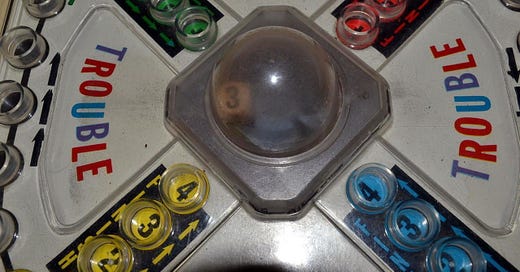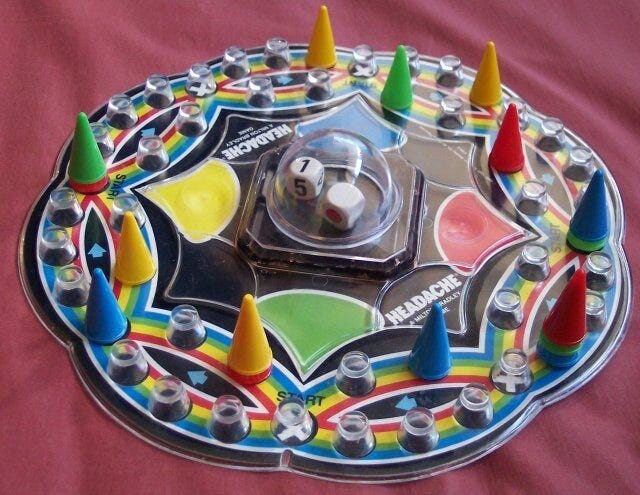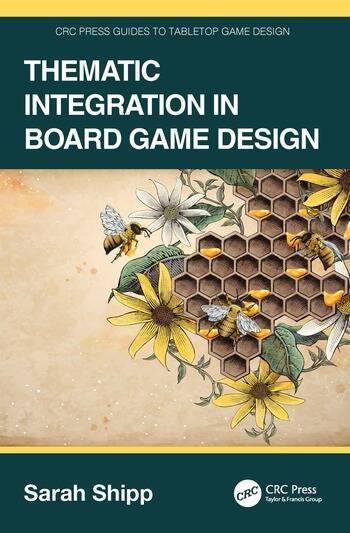The research this article is based on was performed back in 2018. I discussed it on the Dice Tower, but never shared the detailed underlying data and pretty graphs - until now.
The six-sided die was invented thousands of years ago. Dice have been found in some of the earliest human settlements known.
But we had to wait until 1965 for the next leap in dice technology – the Pop-o-Matic. First introduced by Hasbro in the game Trouble, the Pop-o-Matic is a die captured beneath a clear plastic dome. You roll the die by pushing down, deflecting a spring surface beneath the die and then – pop – you get your number. No more lost dice! No more grubby paws hogging the dice! The perfect blend of games and technology.
But a key question about Pop-a-Matic technology went unanswered. How random is it? Does the mechanism give results that are indistinguishable from a good dice tower?
We here at GameTek labs are up to this challenge. To conduct this study, I purchased a new copy of Trouble from Walmart for $8. I then proceeded to pop the Pop-o-Matic 265 times and record the number showing on the die.
Why 265 times? That’s when I got bored. This is how real science is done.
OK – so here are the results.
Normally you would expect each number to come up 16.7% of the time. In my experiment I popped a 1 18% of the time, 2 14%, 3 20%, 4 15%, 5 14% and 6 19%. So it ranged from 14% to 20%.
At first this sounds like a big range – and perhaps a knock against the Pop-a-Matic. But in a sample size of 265, this type of variation is normal. There are a variety of statistical tests that can be performed to see if the rates reflect the expected underlying values – in other words, if I expect something to happen 17% of the time, and it happens 14% of the time, what are the chances of that being the case? Does it mean that I was wrong, and the underlying chances are really 14%? Or that it’s just normal variation based on the fact that I only popped 265 times?
This gets into the realm of statistical analysis, basis rates, and Bayesian analysis. I don’t have time for here – but maybe a future GameTek.
Rather than do a big math analysis, I just asked Excel to generate 265 random die rolls for me, a bunch of times. And a range of 14% to 20% for number frequency, instead of the expected 17% was incredibly common. Here’s a sample:
So the Pop-o-Matic is just as random as a normal die! Huzzah!
Or is it?
One Step Deeper
As a next step, I looked at pairs of numbers rolled together. In other words, if I rolled a 2, what are the chances the next number will be 1, or a 2, 3, 4, 5, or 6? With a normal die roll, or random process, there should be no correlation. The chances should be roughly the same of rolling any number after a 2.
Well, here, sadly, our Pop-o-Matic fails, and fails badly.
When I rolled a 6, there was a 46% chance that the next number would be a 1. When I rolled a 2, there was a 43% chance the next number would be a 5. When I rolled a 3 there was a whopping 51% chance the next number would be a 4.
Here’s a chart of the pairs:
The horizontal axis shows the two rolls, in order. So the bar above ‘34’ is how many times a 3 was rolled, followed by a 4.
There are six spikes scattered through the chart. This is way more variation thatn I would normally expect. And if you look at which pairs the spikes are above the pattern is obvious.
The spikes are 16, 25, 34, 43, 52, and 61.
So when you pop the Pop-o-Matic it is much more likely to just flip to the opposite side of the die. After a 6, a 1 is most likely. After a 5, a 2, and after a 4, a 3.
The force applied to the die is just enough for it to flip completely over most of the time.
The other really interesting thing is that the pop almost always changes the number. Rolling the same number twice was incredibly rare. I rolled ‘doubles’ just seven times out of 265 rolls. That’s a shade under 3%. I would have expected 1/6 to be doubles – forty-four times instead of the seven I rolled.
So I’m sorry Pop-o-Matic fans – as much fun as it is to pop, it’s no substitute for just rolling a die.
One interesting thing though – knowing that the Pop-o-Matic is much more likely to just flip the die can totally be used to make Trouble more tactically dynamic. If you know the most likely numbers to come up next, you can move your pieces to take advantage of that. This will be particularly effective if your opponent doesn’t understand how it diverges from randomness. Here at GameTek we don’t condone gambling, but if you find an underground Trouble game being played for cash, you now have to tools to come out a winner.
Scientific reports usually end with suggestions for future research. So here are two. First, I only tested one game. Is this behavior the same for all of them? Or did I just get unlucky? And did the behavior of the Pop-o-Matic vary over the years? Maybe the games made in the 70’s were better, or had a bigger dome or some other factor that would affect these results.
Another avenue for future research is the game Headache. It also has a Pop-o-Matic, but it has two dice under the dome. How does that affect the rolls? Is it more or less random? Susceptible to the ‘flip the die’ problem? Headache is out of print, but if anyone wants to send me one I’ll be happy to check it out.
The underlying data in this study is available here:
https://docs.google.com/spreadsheets/d/1NkFgySyO97UIYDHQuHTiPZj0jW_2CMhEf7G8B6lyj1E/edit?usp=sharing
If you’ve never tried your hand at data analysis or charting, this is a fun data set to practice on. Let me know if you find some interesting results or ways to view the data!
Announcing a New Book Series!
I am pleased to announce that I am the series editor on a new line of game design books: The CRC Press Guides to Tabletop Game Design. These will be tightly focused deep dives into narrow topics from subject matter experts.
The first two authors are Sarah Shipp, on Thematic Integration, and Daniel Solis on Graphic Design and User Interface. Sarah's book just went up for preorder, releasing in a few weeks, so please check it out!
We plan to release about three books per year in the series, so if you have an idea for a topic, and would like to try your hand at writing please let me know. The books are (relatively) short, at 30-40,000 words, so if you’ve ever wanted to share your experiences in game design to a new generation, this is a great way to do it.










Facinating post! I may protest some of the Trouble games I lost to my sister in the early 1970's due to the Pop-O-Matic inconsistincies you uncovered:) I guess they can update it with some chips and a display upgrade, but the experience wouldn't be as good as the original.
Back in 2018, I bought some empty plastic capsules, the kind you'd see in a little toy vending machine. They were big enough to fit two or three small dice. My idea was to build dice pools and seal them in the plastic capsules.
On your turn, shake a capsule; place it on the board; the types of dice and their results matter.
What stumped me at the time was how this would be better than unsealed dice pools. Adjacencies to different capsules could matter. Being in a sealed container also meant that they could be moved around (carefully) without changing their results. It never quite gelled unfortunately.